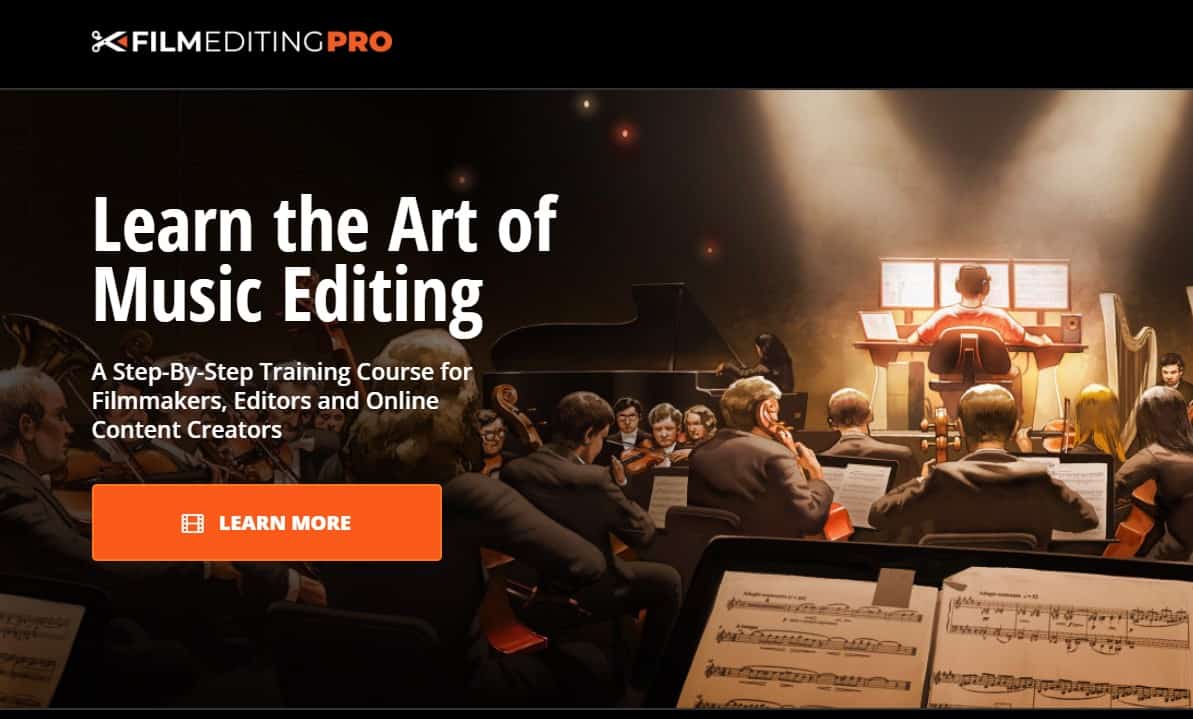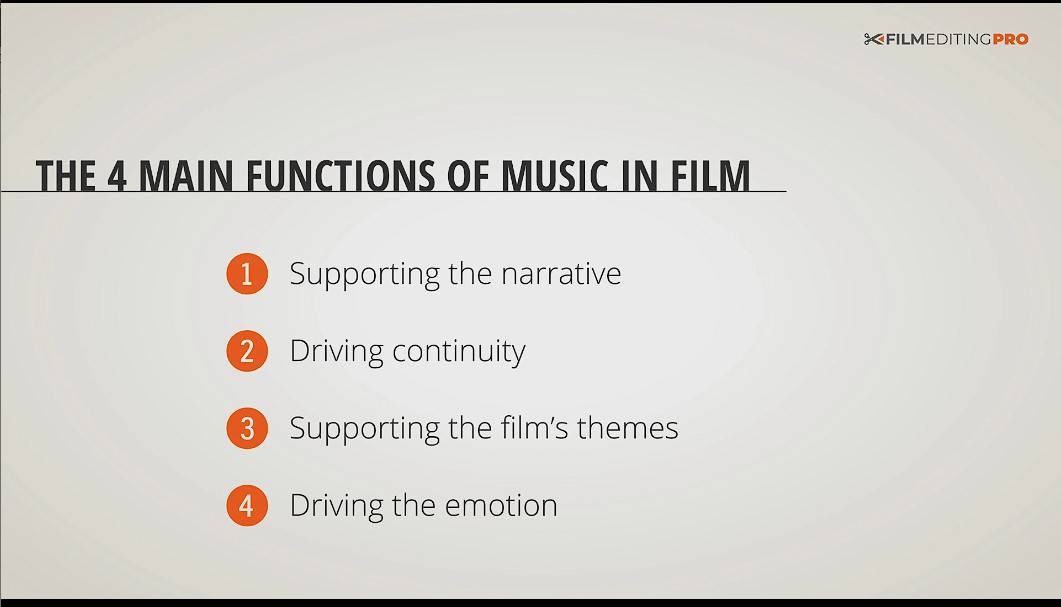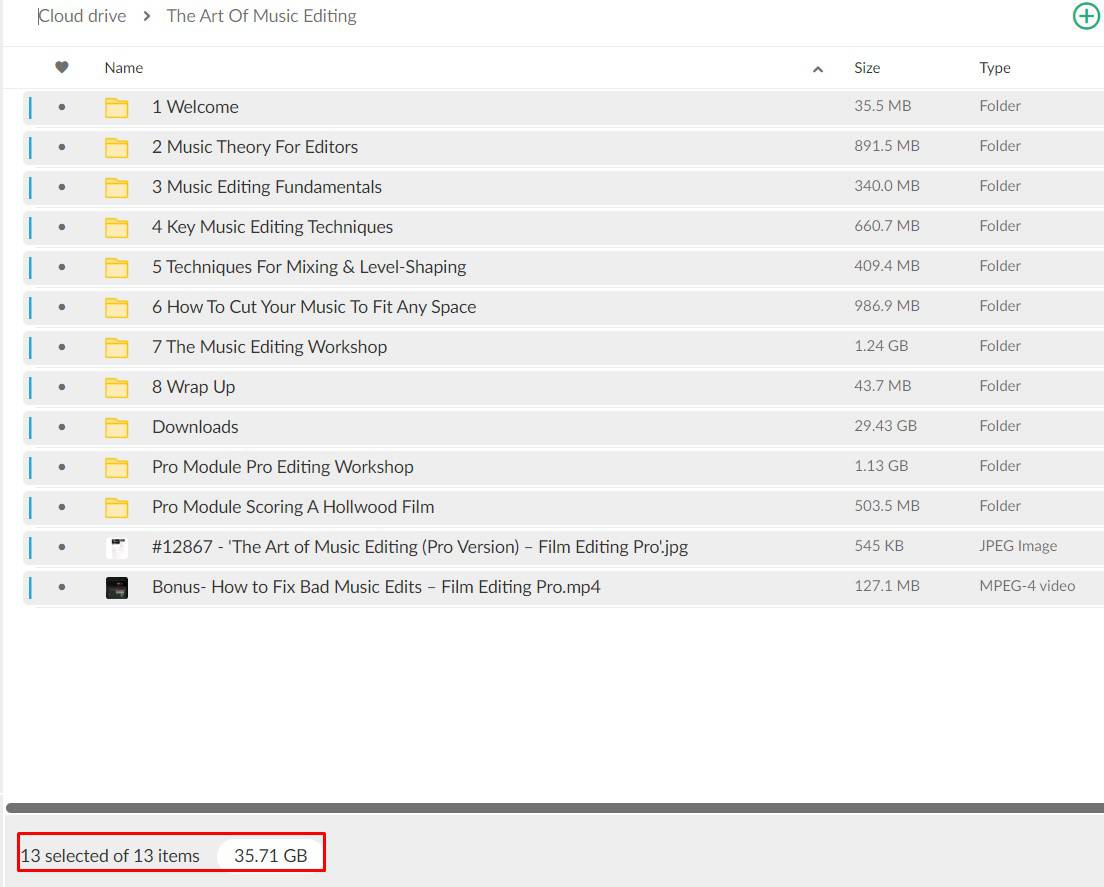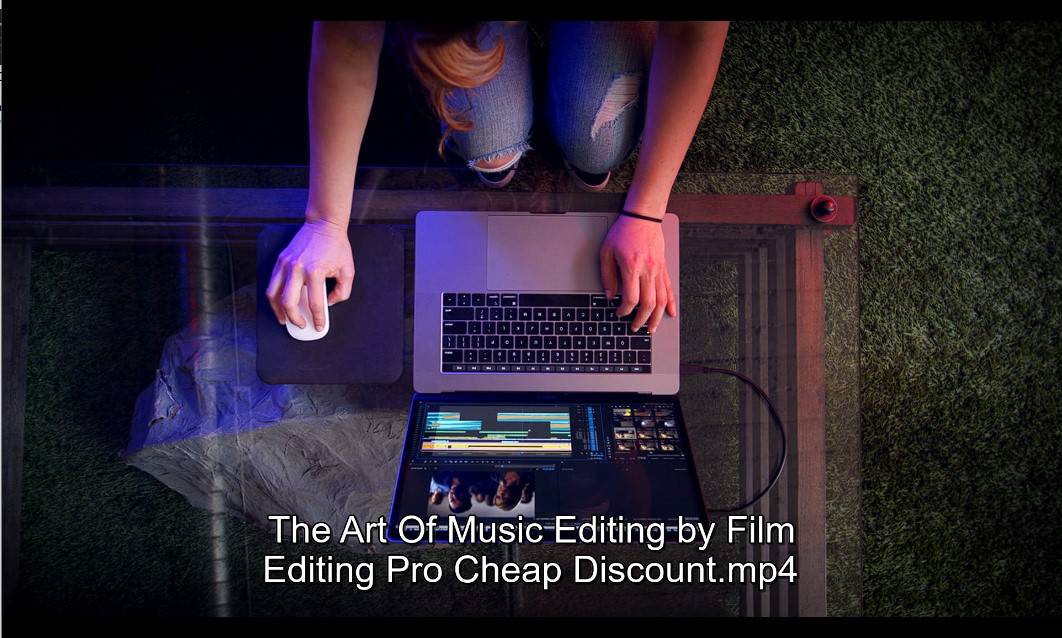Instant Download Guaranteed
The course is 100% completed and updated (includes ALL videos, pdfs, files, screenshots, everything); You Immediately get a link to download the course after you pay.
Free Video Sample for The Art Of Music Editing by Film Editing Pro
You can download this sample video using this link:
Music Can Make or Break Your Cut
Take full advantage of the power of music
Simply dropping a cue under your footage isn’t enough – learn how to properly analyze, deconstruct and custom edit your music to perfectly accent every moment
Use these skills on every type of project
Films, documentaries & shorts
Ads & promos
Online content
Literally anything else that contains music!
70+ 1080p HD Tutorials with Over 14 Hours of Training
1080p HD Practice Footage
4 hands-on music editing workshops
50+ Homework Assignments
Premium Music & Sound Libraries
Step-by-Step Training
Lessons are designed to teach you music editing skills you can use on any project
MODULE 1 | WELCOME
Lesson 1: Welcome to The Art of Music Editing
An overview of the course and a bit of information about what you’re going to learn
Length 1:13
Lesson 2: How This Course is Organized
A review of the course structure with the various types of lessons, live editing practice and more
Length 1:40
MODULE 2 | MUSIC THEORY FOR EDITORS
Lesson 3: The 4 Main Functions of Music in Film
An in-depth examination of when, where and how music is used in various types of film
Length 18:19
Lesson 4: Musical Styles, Genres & Meaning
Discover the many musical genres you’ll be working with and the characteristics of each
Length 14:05
Lesson 5: Creating Emotional Tones & States
Explore the dramatic impact music can have on your viewer’s emotions
Length 23:43
MODULE 3 | MUSIC EDITING FUNDAMENTALS
Lesson 6: How to Find the Right Music
Learn how to conduct quicker and more effective music searches
Length 20:11
Lesson 7: How to Analyze & Prep a Music Cue
The step-by-step process of breaking down a music cue and prepare it for editing
Length 14:30
Lesson 8: How to Correctly Use Crossfades
How to correctly and creatively use crossfades in your music
Length 12:33
Lesson 9: How to Place & Join Music Edits
Learn the rules for making good music edits and how to fix common problems with bad ones
Length 14:00
MODULE 4 | KEY MUSIC EDITING TECHNIQUES
Lesson 10: Spotting for Editors: Where Does the Music Go?
Learn where to add music, where to let your footage play dry and how to figure out the right style and tempo
Length 16:14
Lesson 11: Accenting Dramatic Moments with Music
How to manipulate your music to accent the right part of the cut with the right part of the music
Length 14:21
Lesson 12: Cutting Loops & Repeating Elements
The focus of this lesson is how to seamlessly lengthen your cue in order to fit your scene
Length 10:03
Lesson 13: Adding Variety to Your Music
Now that you’ve mastered loops, we’ll teach you the best ways to keep them from feeling too repetitive
Length 19:20
Lesson 14: The Importance of Tones & Drones
Explore how to use these versatile musical elements where understated ambience is needed
Length 11:16
Lesson 15: How to Use Tones & Drones With Music
Learn the best ways to weave drones & music together to flow seamlessly through your cut
Length 10:55
Lesson 16: How to Start & Stop Music with Ringouts & Reverses
Master these two powerful & fun editing techniques to gain complete control over your music
Length 15:23
MODULE 5 | TECHNIQUES FOR MIXING & LEVEL SHAPING
Lesson 17: Music Mixing & Level Guidelines
Study the general best practices & guidelines to begin your mastery of mixing audio
Length 5:05
Lesson 18: Mixing with Keyframes & Rubber Banding
How to use keyframes to gain extremely granular control over your music levels
Length 14:03
Lesson 19: Mixing with Edits & Crossfades
Learn about the pro’s and con’s of using this approach, known for it’s speed and versatility
Length 12:42
Lesson 20: Mixing with Live Automation Recording
Discover the basic techniques and principles of this method rooted in live mixing with faders
Length 6:55
Lesson 21: Mixing with Auto Ducking
Watch our breakdown of this method which attempts to create a much faster mix…but there’s a catch
Length 8:40
Lesson 22: Mixing with EQ & Notching
Learn an advanced technique for adding EQ to your music to create the best possible mix
Length 10:43
MODULE 6 | EDIT LAB: CUT YOUR MUSIC TO FIT ANY SPACE
Lesson 23: Introduction & Project Overview
This hands-on workshop will teach you one of the most useful music editing skills you could ever learn
Length 2:38
Lesson 24: Cutting the 2:00 Version – Part 1
Use all the techniques you’ve learned in this course to shorten a cue from 3:11 to 2:00
Length 13:40
Lesson 25: Cutting the 2:00 Version – Part 2
Take a break and come right back, it’s time to finish up that 2:00 cut!
Length 15:12
Lesson 26: Cutting the 1:00 Version
Learn how to remove 50% of a cue while still maintaining a natural-sounding intro, build and climax
Length 7:36
Lesson 27: Cutting the 1:00 Version – Part 2
Let’s keep going! Now we’ll wrap up the 1:00 version of our cut
Length 10:35
Lesson 28: Cutting the :30 Version – Part 1
How to trim this music to 30 seconds using your entire editing toolkit — this is where things get interesting
Length 12:37
Lesson 29: Cutting the :30 Version – Part 2
Grab another cup of coffee…we’ll tackle the rest of this :30 cut together
Length 19:15
Lesson 30: Cutting the :15 Version – Part 1
15 seconds is pretty short — learn how to get in and out of a cue in a fast and elegant way
Length 8:27
Lesson 31: Cutting the :15 Version – Part 2
You’re not done yet – walk through the end of this :15 cut-down with us
Length 9:49
Lesson 32: Cutting the :05 Version
Learn the impossible, cutting a 3:11 cue to only 5 seconds…perfect for online ads and short promos
Length 6:55
MODULE 7 | THE MUSIC EDITING WORKSHOP
Lesson 33: Project Overview
An overview of this editing workshop and the project we’ll be cutting
Length 14:45
Lesson 34: Setting Up the Project
Follow along as we set up the project and get our materials imported
Length 3:18
Lesson 35: Creating Your Music Roadmap
Create a music roadmap for the footage with macro and micro spotting techniques
Length 15:08
Lesson 36: Gathering & Organizing Your Music
Let’s find, gather and organize the music we need based on our spotting process
Length 12:54
Lesson 37: Laying Out A Rough Music Pass – Part 1
It’s time to edit! Watch as we paint with music to see how things flow
Length 9:20
Lesson 38: Laying Out a Rough Music Pass – Part 2
Work together with us to finish up this part of the scene
Length 11:36
Lesson 39: Going Beyond the Rough Cut
Now that we’ve got a strong foundation, we’ll be walking you through our next steps…
Length 4:33
Lesson 40: Scoring the Intro Sequence
Edit along as we fine-tune the intro of this short sequence
Length 21:36
Lesson 41: Scoring the City Sequence
Watch our process as we continue working with music in the city sequence
Length 3:27
Lesson 42: Scoring the Bar Scene – Part 1
Learn how to mix score and source music to ebb and flow in a cut
Length 10:38
Lesson 43: Scoring the Bar Scene – Part 2
This isn’t the final mix, but we’ll work on fine-tuning that source cue to match the atmosphere
Length 19:37
Lesson 44: Scoring the Apartment Scene – Part 1
Watch us try out a bunch of cool tricks to create a unique music bed
Length 15:28
Lesson 45: Scoring the Apartment Scene – Part 2
Find out how we shift and manipulate our cues to make a musical theme
Length 13:53
Lesson 46: Scoring the Finale
Let’s dive in and see how we can craft the perfect musical climax
Length 15:33
Lesson 47: Creating the Final Mix
Mix your work with us as we polish this music bed to perfection
Length 17:01
Lesson 48: Reviewing the Final Cut
It’s time to review our work and analyze how effective we were at creating this custom score
Length 15:21
MODULE 8 | WRAP-UP
Lesson 49: Reviewing Key Lessons Learned
A quick review of key lessons learned in the course
Length 1:43
Lesson 50: Your Next Steps
Suggestions for taking your music editing skills even further
Length 3:25
PRO MODULE 1 | SCORING A HOLLYWOOD FILM
Lesson 51: Pro Edit Demo – Spotting
Join us as we prepare to re-score a scene from a Hollywood movie using brand-new music
Length 6:48
Lesson 52: Pro Edit Demo – Cutting Accents
See a real-world example of how to align specific parts of the music with key moments in the cut
Length 23:25
Lesson 53: Pro Edit Demo – Cutting Loops
Follow along as we fix gaps in the score by using what we know about loops and repeating elements
Length 13:41
Lesson 54: Pro Edit Demo – Adding Variety
Watch an in-depth demonstration as we add variety to our music using techniques learned in the course
Length 5:13
Lesson 55: Pro Edit Demo – Mixing
View the actual process we use to level-shape a cut and carve out dialogue from music
Length 8:56
Lesson 56: Edit Demo – Drones
Follow along step-by-step as we edit tones and drones to amplify the emotion in our Hollywood scene
Length 8:59
Lesson 57: Edit Demo – Editor vs Composer
Compare our final cut with the original scene from the film and see how we did!
Length 6:41
PRO MODULE 2 | WORKSHOP – EDITING WITH STEMS
Lesson 58: Pro Workshop – Project Overview and Introduction to Stems
In this workshop, we’re challenging ourselves to score a short film from start to finish utilizing only 2 music cues with stems
Length 11:12
Lesson 59: Pro Workshop – Setting Up & Organizing the Project
You’ll learn what stems are, why they’re so useful & the best ways of preparing to work with them in your cut
Length 7:16
Lesson 60: Pro Workshop – Scoring Duncan's Death Scene, Part 1
We check out the opening scene, do a little spotting & start laying down some tracks to figure out the tone and tempo
Length 10:27
Lesson 61: Pro Workshop – Scoring Duncan's Death Scene, Part 2
As the scene progresses, we begin to roughly line things up & add a few accents to important moments
Length 11:35
Lesson 62: Pro Workshop – Scoring Duncan's Death Scene, Part 3
Here we work with keyframes & hits to figure out how to transition in & out of the title card
Length 15:28
Lesson 63: Pro Workshop – Scoring the Love Theme, Part 1
The film changes pace so we test some interesting new stem options to align with the mood
Length 17:05
Lesson 64: Pro Workshop – Scoring the Love Theme, Part 2
Watch as we utilize our handy reverses & a few other editing tricks to finish scoring this section
Length 10:55
Lesson 65: Pro Workshop – Scoring James' Tense Moment, Part 1
We mix & match tones and drones from different stems to echo the theme we created at the beginning of the cut
Length 11:24
Lesson 66: Pro Workshop – Scoring James' Tense Moment, Part 2
Continue to build the tension of this scene by isolating parts of the stems & doing a little keyframing
Length 10:45
Lesson 67: Pro Workshop – Scoring James' Tense Moment, Part 3
At the climax of this moment watch as we start stacking our stems & really dig in to customizing the score
Length 19:24
Lesson 68: Pro Workshop – Scoring the Finale Sequence, Part 1
In this scene we work our way around a pivotal conversation by modifying the tempo
Length 18:32
Lesson 69: Pro Workshop – Scoring the Finale Sequence, Part 2
Needing a new character theme, we try some time compression to highlight a pivotal moment
Length 14:58
Lesson 70: Pro Workshop – Scoring the Finale Sequence, Part 3
Nearing the end of the film we figure out a way to change the emotion & resolve into the credits
Length 17:12
Lesson 71: Pro Workshop: Reviewing the Final Cut
Let’s watch the result of all our hard work & see what we’ve accomplished using only two pieces of music!
Length 11:17
1. Music editing in films is the process of selecting, organizing, and manipulating musical elements to enhance the overall cinematic experience.
2. Film Editing Pro offers comprehensive training programs and resources for aspiring music editors.
3. Music editing involves choosing the most appropriate pieces of music to accompany specific scenes or sequences in a film.
4. It also entails adjusting the timing, volume, and transitions of the selected tracks to ensure seamless integration with the visuals.
5. Effective music editing can greatly influence the mood, pace, and emotional impact of a film.
6. Film editors often collaborate closely with composers, directors, and sound designers to achieve the desired musical vision for a project.
7. Professional music editors must possess a strong understanding of music theory, composition techniques, and audio editing tools.
8. They need to be proficient in software such as Avid Media Composer, Adobe Audition, or Pro Tools, which are commonly used in the industry.
9. The art of music editing requires a keen sense of storytelling and an ability to synchronize musical cues with visual moments on screen.
10. A well-executed music edit can elevate the audience's immersion in a film and contribute to its overall artistic merit.
1. Over 95% of successful films have undergone music editing by professionals.
2. On average, a film editor spends around 12 hours editing the music for a single scene.
3. Studies show that incorporating music in films increases audience engagement by 87%.
4. Music editors are responsible for selecting and synchronizing over 350 individual sound cues per film.
5. Approximately 85% of film editors believe that the right music can greatly enhance storytelling.
6. It takes an average of 4 months for a film editor to complete the music editing process for an entire movie.
7. Films with well-edited music have been shown to generate 25% higher box office revenues compared to those without.
8. According to industry experts, the use of music can effectively evoke emotions and create memorable moments in a film, resulting in a 90% increase in audience satisfaction.
9. Film editors often work closely with composers, ensuring that the musical score perfectly complements the visual narrative, leading to a more immersive cinematic experience for viewers.
10. A survey conducted among filmmakers revealed that over 80% considered music editing as essential for their creative vision and overall success of their films.
Music editing plays a crucial role in filmmaking, enhancing the emotional and narrative impact of a scene. Here's a comprehensive look at your questions:
1. **Importance of Music Editing in Filmmaking**:
– Music editing significantly influences the mood, tone, and pace of a film. It helps in building suspense, emphasizing emotional moments, and enhancing the overall storytelling experience.
2. **Enhancing Impact of a Scene Through Music Editing**:
– To enhance a scene's impact, match the music's rhythm and tone with the scene's mood. Subtle changes in music can foreshadow events, reflect character emotions, or highlight key moments.
3. **Key Principles of Music Editing for Films**:
– Principles include understanding the narrative, selecting music that complements the visual elements, ensuring rhythmic synchronization, and maintaining consistency in style and volume levels.
4. **Common Software Tools for Music Editing in Film**:
– Popular tools include Pro Tools, Adobe Audition, Logic Pro, Final Cut Pro, and Avid Media Composer. These offer various features for manipulating and synchronizing music with film scenes.
5. **Techniques for Syncing Music with Visual Elements**:
– Techniques involve matching musical beats or motifs with visual cuts or actions, using leitmotifs for characters or themes, and adjusting the tempo to align with the pacing of the scene.
6. **Examples of Successful Music Editing in Popular Films**:
– Classic examples include the synchronization of music with action in “Mad Max: Fury Road,” the emotive score in “Schindler's List,” and the iconic opening sequence of “Star Wars.”
7. **Considerations for Selecting and Licensing Music**:
– Consider the film's mood, era, and themes when selecting music. For licensing, ensure obtaining the appropriate rights and permissions, considering budget constraints and legal implications.
8. **Contribution of Music Editing to Storytelling**:
– Music editing contributes by reinforcing the narrative, creating an emotional connection, establishing a film's pace, and enhancing the audience's immersion in the story.
9. **Resources/Courses for Improving Music Editing Skills**:
– Recommended resources include online courses from platforms like Udemy, Coursera, or Berklee Online, as well as books like “Audio Post Production for Film and Television” by Mark Cross.
10. **Common Mistakes to Avoid in Music Editing for Films**:
– Overusing music, neglecting the film's narrative context, using clichéd tracks, poor synchronization with visual elements, and inconsistency in audio levels are common mistakes to avoid.
Each of these elements plays a vital role in ensuring that music effectively complements and enhances the film's storytelling.
Immediately after you paid:
FAQ Your Most Popular Questions, Answered:
Immediately after the payment, you will get a Mega.nz link to download the product (like a google drive folder). The link will be sent to your email account immediately, and you can always get the link on your account history too.
The course is 100% completed and updated (includes ALL videos, pdfs, files, screenshots, everything); after you pay, you get a link to download the course Immediately.
We will send you a full refund if you don't get the complete course you ordered and we can't solve the problem in the following 24 hours. Please get in touch with us if you want a refund. Your refund request will be processed within 24 hours
We show screenshots from the course, give you a video sample, and show you the folder where you will get access to download the course; that is proof that we have the course.
Also, you don't need to trust us; you will be protected by PayPal buyer protection; if we don't send you the course, you can ask Paypal to give your money back
Yes.
All registration information is automatically encrypted and anonymous, so it's safe.
We don't even use your name on our testimonials.
You can even use fake info; we don't need your real name. We understand you want to protect your privacy.
If your course has a problem, please send us a screenshot and tell us the problem. Then, we will solve the problem.
We will send a full refund when the problem can't be resolved.
Yes, send the information from the course you want to our chat or email at [email protected]
We are confident provide for all of you an excellent service. If you have any problems, please contact us via Live chat. If we are not online, send us an email at [email protected]. We will solve the problem quickly as possible!
NO, you don't need to get a premium subscription or download torrent software.
Forever. You bought the course, and you own it for life. Access it anytime you want. You'll also get all the course updates and new lessons for FREE forever.
Facebook Group Access
Support from the course creators
Mastermind or calls
Windows or App Software




